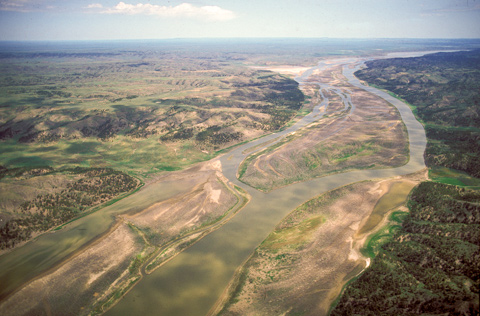See also Charles M. Russell.
The wind against them again on 25 May 1805, the Corps had to tow their boats with ropes among islands such as those in the photograph. Early that morning they “passed a Creek 20 yard wide affording no running water,” now called Two Calf Creek, seen at left. Springtime rivulets had washed rocks into the Missouri at the mouths of streams and gullies, creating obstacles for the men as they waded through the shallows close to shore. Around these submerged hazards, Lewis observed, “the water run with great violence, and compelled us in some instances to double our force in order to get a perorogue or canoe by them.” In other words, the bow rope had to be slackened more than the stern rope, which caused the boat to be drawn out of the slack current near shore into the main stream, requiring additional men on both ropes in order to retain control of the craft and make headway. It was a slow, risky maneuver.
Separately, the captains explored the “high broken and rockey” terrain that hemmed in the river on both sides. This rugged area, known as the Missouri Breaks, was created when glaciers forced the Missouri River southward from its original course down today’s Milk River basin. “In my walk of this day,” wrote Clark, “I saw mountts. on either side of the river at no great distance. . . . I also think I saw a range of high mounts. at a great distance to the S S W. but am not certain as the horozon was not clear enough to view it with Certainty.”
That evening Clark shot the expedition’s first specimen of a bighorn sheep (Ovis canadensis), a species they had heard about from various sources, and had first seen a month earlier. Remembering Jefferson’s instruction to watch for fauna that might have been thought extinct, Lewis recalled that he had obtained some bones from the head of a similar animal at Big Bone Lick in Kentucky, on his trip down the Ohio in 1803, but made no more of the apparent coincidence.
Clark concluded his description of the bighorn with the remark that “The flesh of this animal is dark and I think inferior to the flesh of the Common Deer, and Superior to the antilope of the Missouri and the Columbian Plains—. (emphasis added). Inasmuch as the Corps didn’t see the “Columbian Plains” for the first time until the following October, those last four words indicate that this was one of those instances when a journal entry was written many months after the fact.[1]Moulton, Journals, 4:200n.
From Discovering Lewis & Clark from the Air
Photography by Jim Wark
Text by Joseph Mussulman
Reproduced by permission of Mountain Press
Notes
| ↑1 | Moulton, Journals, 4:200n. |
|---|
Experience the Lewis and Clark Trail
The Lewis and Clark Trail Experience—our sister site at lewisandclark.travel—connects the world to people and places on the Lewis and Clark Trail.
Discover More
- The Lewis and Clark Expedition: Day by Day by Gary E. Moulton (University of Nebraska Press, 2018). The story in prose, 14 May 1804–23 September 1806.
- The Lewis and Clark Journals: An American Epic of Discovery (abridged) by Gary E. Moulton (University of Nebraska Press, 2003). Selected journal excerpts, 14 May 1804–23 September 1806.
- The Lewis and Clark Journals. by Gary E. Moulton (University of Nebraska Press, 1983–2001). The complete story in 13 volumes.


